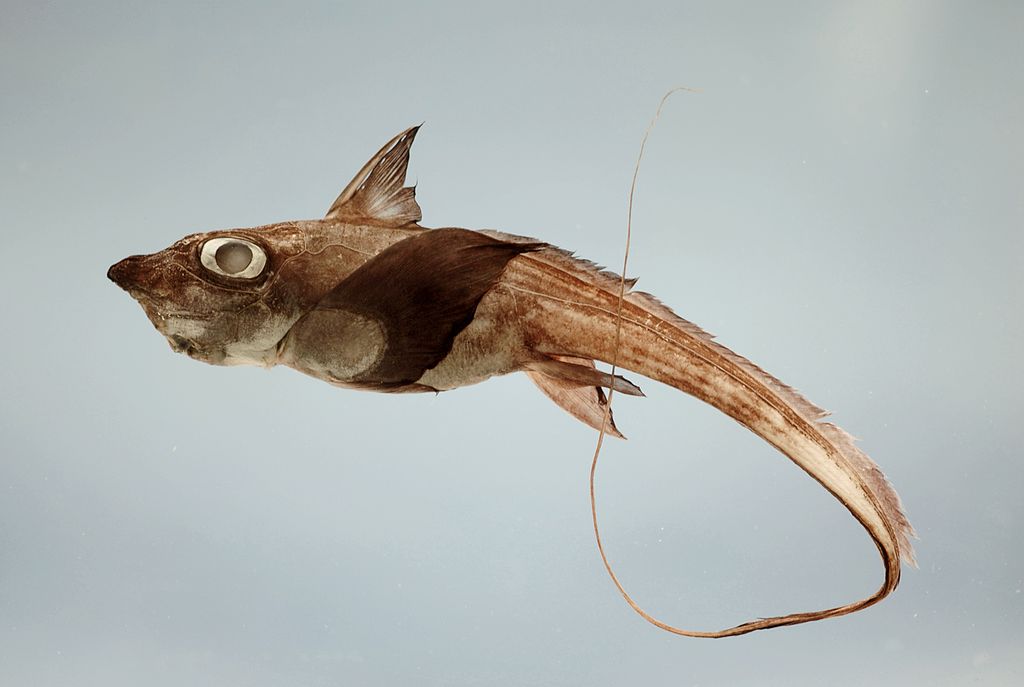Pressure-depth relation | Hydrostatic pressure
The deeper we sink into a fluid, the greater the pressure in the fluid becomes. The extra pressure originates from the weight of the fluid and is called hydrostatic pressure.
Pressure-depth relation
If the pressure at a certain depth in the fluid is \(p_0,\) the pressure at a depth equal to the previous depth plus \(h\) is
\[p(h) = p_0 + \varrho h g.\]
Example: deep-sea fish

Certain fishes live thousands of metres below sea surface. Take a depth of \(h = 1000\,\mathrm{m}\) for example. The pressure at sea level is the atmospheric pressure \(p_0 \approx 10^5\,\mathrm{Pa},\) whilst at a depth \(1000\,\mathrm{m}\) it is
\[p = p_0 + \varrho h g = 10^5\,\mathrm{Pa} + 1000\,\,\frac{\mathrm{kg}}{\mathrm{m}^3} \cdot 9.81\,\frac{\mathrm{m}}{\mathrm{s}^2} \cdot 1000\,\mathrm{m} = 9.91 \cdot 10^6\,\mathrm{Pa}.\]
This is \(\approx 100\) times as much as atmospheric pressure. Deep-sea fish do not get crushed, though, as the pressure inside them is the same as the pressure in their surroundings. But it also means that if you bring such a species to the surface of the sea, they will burst as the internal pressure within them is so much greater than the external pressure at sea level.
Proof: pressure-depth relation
Let us assume that we have an incompressible fluid of density \(\varrho\) at rest. We pick the fluid contained within an imaginary cylinder of cross-sectional area \(A\) extending from depth \(d\) to depth \(d + h.\) The external fluid exerts forces at all points on the surface of the sample, perpendicular to the surface.
The net lateral force acting on the fluid cylinder is zero as if we pick a small area in a given depth, the force acting on it will be of the same magnitude but of opposite direction as the force acting on an equal lateral area located opposite the first one at the same depth.
Let us denote the pressure on the top face by \(p_0\) and the pressure on the bottom face by \(p.\) To get the net force acting on the selected fluid cylinder is the vector sum of the forces associated with \(p_0\) and \(p\) plus the force of gravity. Since the fluid is stationary, this net force must be zero. The equilibrium condition in the vertical direction: \[\sum{F_y} = 0 = p A - m g - p_0 A.\] The mass of the sample can be expressed using the density and the volume: \[m = \varrho V = \varrho A h.\] Substituting this into the equilibrium equation we get \[0 = p A - \varrho A h g - p_0 A.\] Dividing both sides by \(A\) and rearranging, we obtain the pressure-depth relation:
\[p = p_0 + \varrho h g.\]
Hydrostatic paradox
The pressure \(p\) at a given depth does not depend on the shape or the cross section of the container. If the fluid level is the same, the pressure at the bottom of these containers is also the same, regardless of the shape of the container.